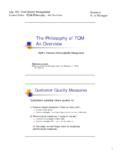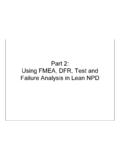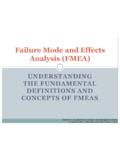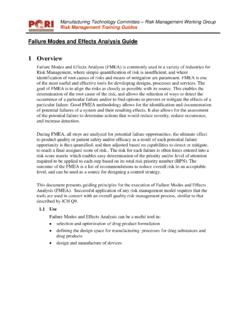Transcription of Developing a FMEA
1 Developing a FMEA .. REFERENCE ONLY Get the Boundary Diagram this helps define the scope of the FMEA Get the Interface Matrix, P-Diagram, Process Flow Chart (identify the sources of variation) Include a reference to rating tables General (header) List all assumptions in detail in the first couple of lines of the FMEA Note the part name & number in the header List all team members in the header (involve the cross-functional team early and as warranted don't develop a FMEA in a vacuum). Revision date, as appropriate, must be documented Function Write the function in physical, technical and measurable (verb-noun) terms example: during operation, the door must not fragment. Or - as specified in functional spec #_____; rev. date_____ Failure Mode Identify all 5-types of failure modes: total failure, partial failure, intermittent failure, over-function & unintended function Write the failure modes as anti-functions using verb-noun format example: door fragmentation results in pieces thrown at the occupant.
2 Effect(s) of Failure List effects in a manner that the customer would describe them Include the next higher assembly, system, vehicle, machine/equipment, safety, next operation(s), customer & regulatory requirements, manufacturing, assembly, service (as appropriate) example: occupant injury caused by door fragments Severity (Rating) Severity values should correspond with standard guidelines Make sure that there is one severity rating for each failure mode by taking the most serious case for the failure mode and using the rating table example: occupant injury caused by door fragments severity 9 Developing a FMEA .. REFERENCE ONLY Classification Classification should be used to define potential critical and significant characteristics Critical characteristics (9 or 10 in severity) must have associated recommended actions Significant characteristics (5 thru 8 in severity with 4 thru 10 in occurrence) should have associated recommended actions (example - see the formula used in Excel to determine YC & YS) HKAction ResultsREF #Item/FunctionPotential Failure ModePotential Effect(s) of FailureSeverityClassPotentialCauses(s) Mechanism(s)of FailureOccurrenceCurrent DesignControls / Verification MethodsDetectionRPNR ecommended Action(s)Responsibility& TargetCompletion DateActionsTakenSeverityOccurrenceDetect ionRPN119YC5145=IF(OR(H11>8),"YC",IF(AND (H11>4,K11>3),"YS","")) example.
3 Cover not stiff enough causing injury Cause(s) of Failure Limit the causes to design concerns - use the P-Diagram & Interface Matrix to determine causes Analysis must stay within the defined scope per the Boundary Diagram Causes at component level analysis should be identified as part or system characteristic (a feature that can be controlled or fixed at process) Try to identify all causes for each failure mode, circle back as needed (there is usually more than one cause of failure for each failure mode) Exclude manufacturing/assembly causes in the DFMEA but include them in the PFMEA Identify the causes for a failure mode, not an individual effect example: incorrect door material specified inadequate design validation testing at different temperatures Occurrence (Rating) Occurrence values should correspond with standard guidelines Occurrence ratings for design FMEA are based upon the likelihood that a cause may occur, past failures, performance of similar systems in similar applications, or percent new content.
4 Rating should be based on the likelihood of detecting the first level causes (element failure modes) or the failure mode prior to engineering, manufacturing or assembly release Occurrence values of 1 must have objective data to provide justification, data or source of data must be identified in 'Recommended Actions' column example: incorrect seam design occurrence 3 Developing a FMEA .. REFERENCE ONLY Current Design Controls Preventive controls are those that help reduce the likelihood that a failure mode or cause will occur affects occurrence value Detective controls are those that find problems that have been designed into the product assigned detection value Clearly identify preventive and detective controls Ensure that the methods listed detect the causes or failure modes example: engineering specifications preventive control; historical data preventive control.
5 Functional testing detective control Detection (Rating) Detection is the value assigned to each of the detective controls Detection values of 1 must eliminate the potential for failures due to design deficiency example: engineering specifications detection 1 historical data detection 1 functional testing detection 4 general vehicle durability detection 5 RPN (Risk Priority Number) Risk Priority Number is a multiplication of the severity, occurrence and detection ratings Lowest detection rating is used to determine RPN RPN threshold should not be used as the primary trigger for definition of recommended actions example: occupant injury caused by fragments severity 9, incorrect seam design occurrence 3 functional testing detection 4, RPN = 9 x 3 x 4 = 108 Action Results Remedial actions taken must detail what actions occurred, and the results of those actions Unless the failure mode has been eliminated, severity should not change Occurrence may or may not be lowered based upon the results of actions Detection may or may not be lowered based upon the results of actions If severity, occurrence or detection ratings are not improved, additional recommended actions must be defined Ensure special manufacturing/assembly controls for Special Characteristics Developing a FMEA.
6 REFERENCE ONLY Rating Chart Severity Occurrence Detection Rank Hazardous Without Warning very high severity ranking when a potential failure mode affects safe vehicle operation and/or involves noncompliance with gov't regulation without warning. Very High persistent failures 100 per thousand vehicles / items Absolute uncertainty design control will not and/or cannot detect a potential cause/mechanism and subsequent failure mode, or there is no design control. 10 Hazardous With Warning very high severity ranking when a potential failure mode affects safe vehicle operation and/or involves noncompliance with government regulations with warning. Very High 50 per thousand vehicles / items Very Remote very remote chance the design control will detect a potential cause/mechanism and subsequent failure mode. 9 Very High vehicle/item inoperable (loss of primary function) High: Frequent Failures 20 per thousand vehicles/items Remote remote chance the design control will detect a potential cause / mechanism and subsequent failure mode 8 High Vehicle / item operable but at a reduced level of performance.
7 Customer very dissatisfied. High: Frequent Failures 10 per thousand vehicles/items Very Low very low chance the design control will detect a potential cause / mechanism and subsequent failure mode. 7 Moderate vehicle / item operable but comfort/convenience item(s) inoperable. Customer dissatisfied. Moderate: Occasional Failures 5 per thousand vehicles / items Low low chance the design control will detect a potential cause / mechanism and subsequent failure mode. 6 Low vehicle / item operable but comfort / convenience item(s) operable at a reduced level of performance. Customer somewhat dissatisfied. Moderate: Occasional Failures 2 per thousand vehicles / items Moderate moderate chance the design control will detect a potential cause / mechanism and subsequent failure mode. 5 Very low fit & finish / squeak & rattle item does not conform.
8 Defect noticed by most customers (> 75%). Moderate: Occasional Failures 1 per thousand vehicles / items Moderately High moderately high chance the design control will detect a potential cause / mechanism & subsequent failure mode. 4 Minor fit & finish / squeak & rattle item does not conform. Defect noticed by 50 % of customers. Low: Relatively Few failures per thousand vehicles / items High high chance the design control will detect a potential cause / mechanism and subsequent failure mode. 3 Very Minor fit & finish / squeak & rattle item does not conform. Defect noticed by discriminating customers (< 25 %). Low: Relatively Few per thousand vehicles / items Very High very high chance the design control will detect a potential cause / mechanism and subsequent failure mode. 2 None no discernible effect. Remote: Failure is Unlikely per thousand vehicles / items Almost Certain design control will almost certainly detect a potential cause / mechanism and subsequent failure mode.
9 1








